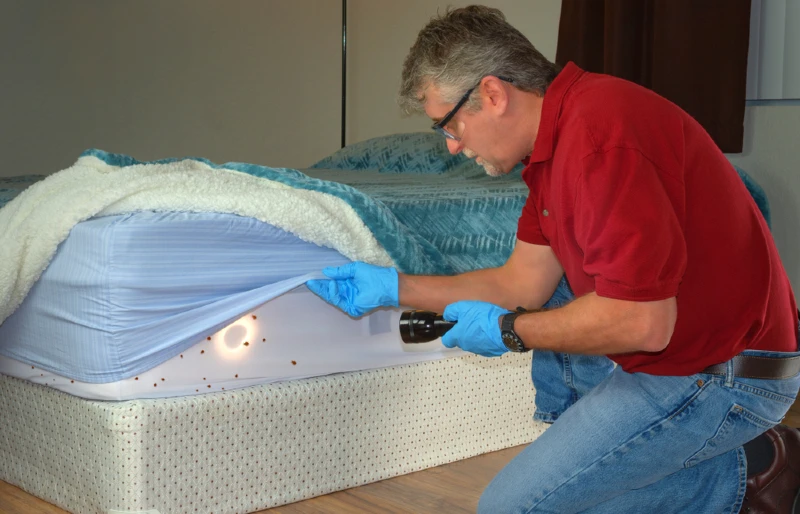Does Renters Insurance Cover Bed Bugs? The Surprising Answer!
-

- Last updated:

Bed bugs are a worldwide menace. Though initially thought to affect developing countries, they can be found in the USA and Canada. If you have ever been attacked by them, you know too well how many sleepless nights the menace forced you through. They irritate as they bite through the skin, and the topic of eradicating them is never too far away.
With the average cost of exterminating bed bugs around $1,700, the problem is costly to solve.1 But what if the problem is on a rented property? Would you think of shifting the responsibility to another party?
Well, if you have renters insurance that covers bed bugs, the company will eradicate them. Unfortunately, many large insurance companies in the USA do not cover damages caused by bed bugs. It is usually the landlord’s or your responsibility.
Why Aren’t Insurance Companies Providing Covers for Bed Bugs?
Renters insurance is a form of property policy that protects homeowners against covered risks associated with a rental property. A rental property can be an apartment, condominium, or mobile home.
Typical renters’ insurance covers three areas:
Personal possession
Here, the cover is responsible for material things within the home. It covers perils such as fire, vandalism, and weather-related damages that may result in loss of property.
Liability
Liability coverage protects you against damages caused to other tenants, damages that occurred to other people inside your home, or when sued for damages caused by a certain event on your property. The damage may be caused by you, your family members, or pets.

Additional expenses
If your rented property becomes uninhabitable, let’s say, due to a fire that damages the elevator and the building’s foundation, an insurance company will cover expenses associated with renting a hotel room. However, before you file for additional expense claims, understand the policies provided by the cover.
From the three generalized areas, why are bed bugs not part of them, yet it’s a peril?
To understand that, one of the key things you must know is insurance covers sudden disasters. Bed bugs are not considered “unexpected disasters” because they could be avoided through routine maintenance.
When a company states it will not cover bed bugs, it also means any damages associated with them, for example, the cost of a mattress that could not have been salvaged after an infestation.
Are There Insurance Coverage Options That Cover Bed Bug Damages?
Some renters insurance companies do not have an actual bed bug cover, but they have an endorsement. An endorsement or rider is an add-on to the actual policy, which may cover certain damages related to bed bugs or a specified peril.
According to Forbes, American National Property and Casualty Co. has a bed bug add-on of $500, $750, or $1,000 per annum. With the add-on, the insurance company covers for:
- The amount of money spend on fumigants and fumigation experts
- The cost of cleaning and sanitizing residences
- The cost of disposing of infested mattresses, pieces of furniture, and clothing
- Charges related to sealing and treating adjacent homes or units to stop the infestation
- Additional expenses associated with renting a hotel room while your home is being worked on

Can the Landlord Pay for Bed Bug Extermination?
Similar to renters insurance, a landlord may or may not pay for costs associated with the eradication of bed bugs. It depends on where you live.
In states like New York City and Maine, the landlord is fully responsible for the eradication of bed bugs within 30 days of receiving the complaint. This means the cost of pest exterminators and boarding expenses of tenants if they were forced to move out for some days is on the property owner.
On the other side, states like Arizona and California require the landlord to provide information related to the history of bed bug infestations on their property.
For more information on bed bug laws, talk to housing authorities from your city or state. The Environmental Protection Agency (EPA) may also have useful information.
How Do You Exterminate Bed Bugs?
You can exterminate bed bugs at home using simple tools and chemicals. Here are the steps to do so:
1. Identify Bed Bugs

Early identification of bed bugs reduces the cost of eradication. You may find bed bugs between bed frames, on the headboard, furniture joints, between cushions, and underneath the mattress.
When called upon, experts may come with specially trained dogs that detect pheromones produced by bed bugs.
2. Contain Bed Bugs
Vacuum bed bugs from suspected areas and any hiding places. Bed bugs live in clusters, and if you spot one, others may be just around, so focus your efforts within a 3-foot radius.
After vacuuming, empty the contents into a plastic bag and tightly seal it. Lastly, place the bug under the hot sun for a few days before disposing of it while it is still sealed. The hot sun kills some of the bugs and eggs.
3. Kill the Bugs

To ensure bed bugs will never bother you again, you must kill them. There are several ways to kill bed bugs.
Non-chemical ways
These are the safest but least effective ways of killing bed bugs. The method involves using temperatures below 32 degrees Fahrenheit and higher than 130 degrees Fahrenheit. If you are using high temperatures, make sure the bugs are exposed to intense heat for more than 2 hours.
Please note that since bed bugs are very mobile, they may try to find cooler regions, rendering the method ineffective.
Chemical ways
Chemical ways of controlling bed bugs involve insecticides and fumigants. Some examples include:
- Pyrethroids
- Pyrroles, such as chlorfenapyr
- Neonicotinoids, which damage the bugs’ nervous system
- Desiccants such as silica aerogel destroy the bugs’ protective exoskeleton. Without it, the bed bug will die due to dehydration. The only downside is they take months to kill bugs.
In Conclusion
Renters’ insurance rarely covers bed bugs and damages related to them. This is because bed bug damage is not a sudden or unexpected event and can be avoided through maintenance. For more information, visit Lemonade Renters Insurance (LMND).
See Also:
- Does Renters Insurance Cover Broken Windows? All You Need to Know!
- Does Renters Insurance Cover Bike Theft? All You Need to Know!
- Does Renters Insurance Cover Bed Bugs? – Forbes Advisor
- State Bed Bug Laws – state_bed_bug_laws_and_regulations_september_2019.pdf
- CDC – Bed Bugs – Frequently Asked Questions (FAQs).
- How much does it cost to exterminate bed bugs? – V Extermination
Featured Image Credit: Andrey_Popov, Shutterstock
Contents


